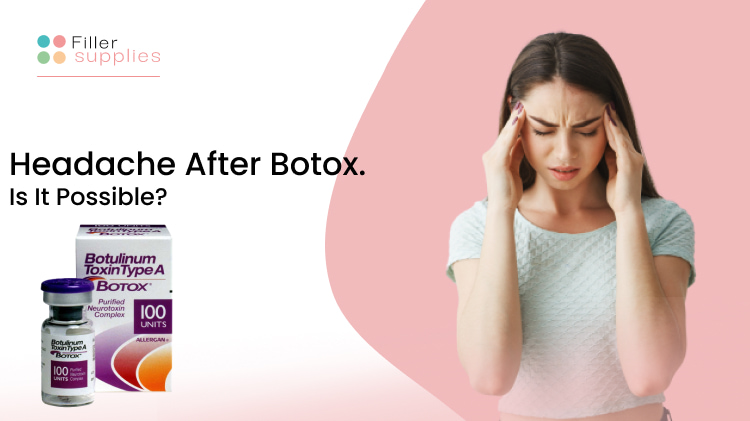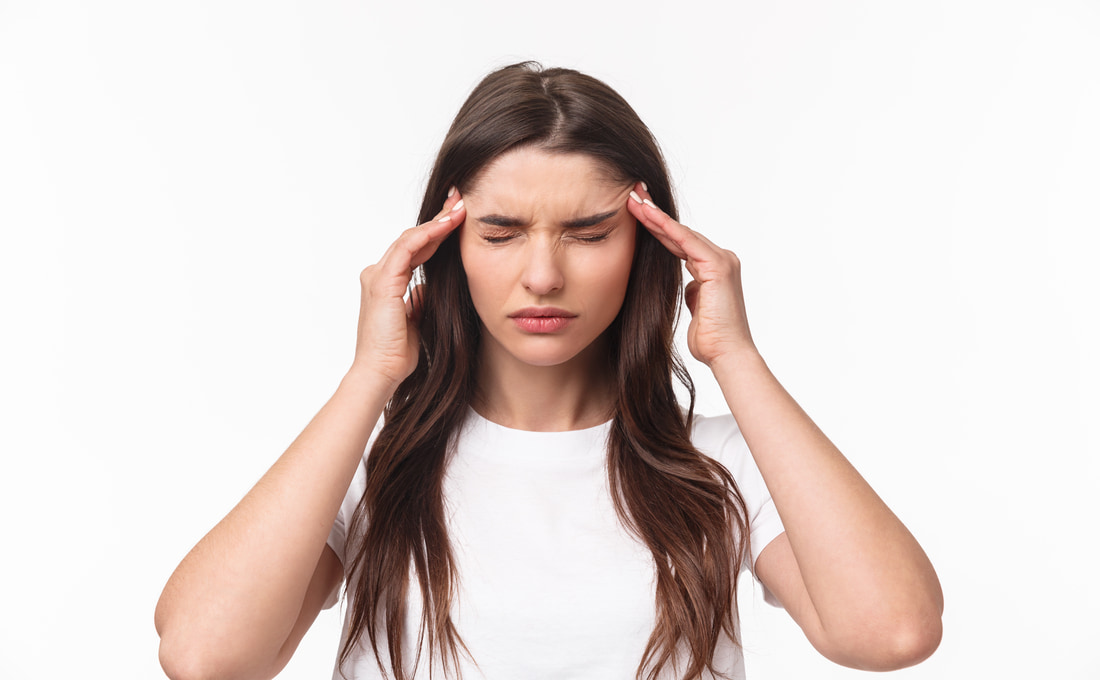Unmasking the Side Effects: Unraveling the Mystery of a Headache After Botox

Botox is a brand widely known worldwide thanks to its muscle spasm treatment abilities. This solution uses botulinum toxin type A as its main active substance, making it one of the best products to pause the nerve endings contractions in muscles and provide a significant improvement in various spheres, including cosmetic and medical ones. And while wrinkles prevention is something most people know about, Botox’s medical uses are not as widely discussed, so we believe it’s a nice opportunity to cover this topic and answer some atypical questions about all the incredible abilities of botulinum toxin injections.
Today, we would like to concentrate more on Botox for chronic migraine prevention and some unusual adverse reactions people may experience afterward. And, of course, we will answer one of the most frequently asked questions about this procedure; to be more precise, we are going to unmask the nature behind a mild headache after botulinum toxin injection. Every day is a good day for discovering something new, so let’s dive together into this intriguing topic!
Botox for Migraines Overview
Botox is an untraditional way to deal with a severe headache; typically, it’s recommended for people who cannot benefit from more usual forms of this problem’s solution, such as painkillers or massages. To use this procedure, a person should experience chronic pain for a few days in a row, overall making it 14 or more headaches per month. In addition to headache frequency, some individuals also notice severe neck pain that can lower to the shoulders and other neighboring areas.
Working Principle of the Procedure
Before the procedure, the areas that experience the most headache pain are defined to create a map for administration spots understanding. Afterward, the dosage is calculated based on the severity of the problem and a customer’s health statement.
The solution is injected into the zones around the pain fibers to enter the nerve endings later, stop muscle contractions, and pause the release of chemicals responsible for pain transmission. This way, the pain network in the brain cannot act appropriately.
One treatment typically lasts up to 10-12 weeks, so it’s highly recommended to schedule repetitive injection sessions to ensure the effect doesn’t wear off and a person is comfortable throughout the post-treatment period.
Types of Headache Treated with Botox
Botox treatments are unique in their nature and can be rather helpful for individuals with various needs and procedure requests. That’s why it’s important to know all the possible uses of this injectable, including types of headache pain that can be treated with its help. Throughout all problems, we can highlight the followings:
- Migraine headaches. This kind is reoccurring and continuous type of headache typically characterized by pulsating, throbbing pain on the sides of the head. Other unpleasant symptoms, such as nausea, vomiting, and increased light and sound sensitivity, can accompany them. Based on a person’s overall health statement, it can last from a few hours to a few days and affect one’s life quality significantly;
- Tension headaches. This one is one of the most common types of headache, usually affecting both sides of the head. They are typically caused by high tension and stress and feel like a tight band is wrapped around the head. Tension headaches are rarely accompanied by other symptoms and shouldn’t last longer than a few hours to a day;
- Cluster headaches. The last ones we’ll discuss are rare and generally occurs in cyclical patterns or clusters. The headache symptoms tend to appear during a specific period and can last from a few weeks to a few months. Excruciating pain is typically located around one eye or temple, and it may lead to eyes redness and tearing, drooping eyelids, stuffy nose, and others. These are believed to be among the most severe types of headache, so sometimes the only thing that can help is to administer Botox to relax neck and facial muscles.
Recommended Dosage for Headache Treatment
To ensure the Botox treatment is successful and provides the expected results in the end, the correct dosage of the solution must be calculated during the consultation. The average recommended dose is 155 units of botulinum toxin; the best way to administer those is to divide the general amount of product into thirty-one 5 units portions to inject them into seven previously defined zones in the head and neck. Typically, Botox is administered in such regions as the forehead, temples, nose bridge, back of the head, neck, and the area above the shoulders.
Visiting an experienced medical professional is vital to ensure the session is successful and safe, so browsing all the options and reading feedback from other patients is highly recommended. If a person doesn’t have a valid medical license and a perfect knowledge of human body anatomy, they won’t be able to provide proper service with desired outcomes to an individual.
Discover the remarkable effects of dermal fillers on acne scars with our captivating before and after article at Fillersupplies.com. We understand the profound impact acne scars can have on your self-confidence, and we are excited to present you with a comprehensive guide on how dermal fillers can revolutionize your skin.
ON A SIDE NOTE:
To buy Botox online, you must provide your license number or doctor’s prescription so that a supplier can check your qualification. If these topics are ignored, you’ll likely buy products from unreliable sources of questionable quality. FillerSupplies is here to provide the best customer service, so check out the assortment to buy Botox from experienced professionals!
Headache After Botox Injections. Is It Possible?
We understand that this topic may be confusing for some individuals, as Botox is initially used when painkillers and other traditional solutions cannot help with migraines. However, sometimes people experience headaches after the injection session as an unfortunate side effect (less than 1% of them), and it’s important to understand the nature of this problem to deal with it quickly and painlessly.
Some of the theories on this condition claim that this issue is caused by the following:
- Incorrect administration technique (for example, bumping into the frontal bone of the forehead);
- Overcontraction in certain facial and neck muscles;
- Low-quality Botox (purchased from an unreliable supplier).
Typically, post-botulinum headaches may last from a few hours to a few days and fade away gradually with time as the product starts working at its full strength.
How to Deal with Botox Headache After the Treatment?
If you experience extreme pain after the Botox injection session, the first thing you should do is get in touch with a doctor to ensure everything is fine regarding the healing journey. Afterward, they may recommend one or a few of these steps:
- Choose a helpful over-the-counter pain medicine to reduce unpleasant symptoms;
- Adjust the Botox dose for the next treatment session to avoid similar problems in the future;
- Searching for Botox alternatives (maybe, the reaction is caused by the product’s incompatibility with one’s organism).
For now, botulinum toxin injections are among the most popular and well-performing solutions for chronic migraine treatments. Still, this option is not suitable for everyone, so it’s essential to clear out all the most vital details about it before the treatment to ensure the process itself will be pleasant, fast, and non-problematic.
Other Common Botox Side Effects You Should Know
Most cosmetic procedures for skin rejuvenation, as well as medical treatments of various natures, cause adverse reactions in the body. The situation here is quite simple to understand – the body needs time to adjust to the changes and recover even after minimally-invasive procedures. To ensure one’s healing journey is successful and not followed by severe complications, it’s essential to be aware of all potential Botox adverse reactions and the way they can transform into something more serious.
So, what are the side effects people usually experience after botulinum toxin administration?
- Local skin irritation (redness, swelling, itching, etc.);
- Slight bruising in the needle puncture spots;
- Increased skin sensitivity in the target area;
- Headache and mild migraines;
- Etc.
Of course, there are more severe adverse reactions; the chances of those occurring after the procedure are minimal, yet still, it’s better to be aware and contact a doctor if any of these are noticed:
- An allergic reaction;
- Swollen throat and tongue;
- Trouble swallowing;
- Difficulty breathing;
- Increased heart rate;
- Blurred vision;
- Painful sensations in the treated spot;
- “Frozen” facial expression;
- And so on.
The main thing here is not to panic and get in touch with a specialist as quickly as possible. If it’s done on time, all the conditions can be taken under control without problems, so be cautious and don’t let yourself get anxious. Your doctor is your friend, and it’s in their best interest not to let anything bad happen to you.
Aftercare Recommendations for the Procedure
Botox treatment is an effective option for individuals who suffer from chronic migraines; its excellent ability to block muscle spasms offers durable relief to the target audience. All you need is to schedule an appointment in a doctor’s office and create the best-working scheme to perform the treatment. In addition, to ensure the overall experience is positive, it’s vital to be aware of aftercare tips and possible ways to incorporate them into one’s routine.
Among the most helpful pieces of advice, we can highlight the followings:
- Pause blood-thinning medications (and certain supplements) to prevent bruising and swelling. If you need prescription medicines, talk to a doctor about alternatives to ensure there will be no complications afterward;
- Wait for 24 before working out. We understand that it can be a part of everyday routine, but it’s highly recommended to postpone activities that can increase blood flow and spread the solution to the neighboring areas of the target zone;
- Don’t rub the face to avoid Botox distribution. It includes massages, make-up application, intense cosmetic procedures, and other similar activities;
- Don’t lie down for approximately 4 hours after the Botox injection. It may have a negative impact on the healing process and lead to intense bruising and swelling;
- Avoid sleeping on the treated side. Once again, preventing botulinum toxin from distributing is vital for the overall success of the treatment, so pressing on the administration spot is forbidden;
- Stay away from direct sunlight and use SPF daily to protect sensitive skin. This one should be followed not only after the treatment, as the sun is not a friend to us and may be the reason for numerous aesthetic and health problems. Thus, you should always be cautious and cover your skin from harmful UV rays.
If all these recommendations are correctly followed, one’s healing journey must be much easier and less problematic. Remember, your doctor is your best friend in this case, so contact them if any disturbing signs occur after the injection session or if you need a consultation regarding your recovery situation.
To Sum Up: Botox and Headache After the Treatment
Botox for severe migraines is one of the best solutions for this problem. Due to its nature, just one procedure may provide significant relief for an individual (however, it’s better to schedule a few appointments to reach maximum effectiveness with this treatment). After the administration session, botulinum toxin gets to the nerve endings of the targeted muscles and thus pauses their contractions for up to four months, guaranteeing immense relief to a patient.
To ensure this procedure is the right call for a person, it’s essential to consult with a medical professional first to discuss their needs, expected results, and certain important health peculiarities. And, of course, ensure high-quality products are used during the injection session to be safe and satisfied with the final results. That’s it for today’s article. Thank you for reading!

